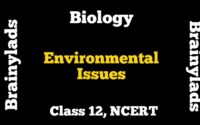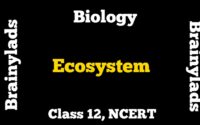Organisms and Populations Class 12 | Term 2 | Ecology | NCERT |
Table of Contents
Organisms and Populations Class 12, Ecology, Term 2
Introduction
- Levels of biological organizations- macromolecules – cells-tissues-organs-organism – population – communities- ecosystem-biomes
- Ecology refers to the interactions among organisms and its physical or abiotic environment .
- Ecology is basically concerned with four levels of biological organisation. Organisms-populations-communities-biomes.
Organisms and its Environment
- At organism level. ecology makes us understand about the adaptations of different organisms to their environment in terms of survival and reproduction.
- The annual variation in the intensity and duration of temperature lead to different season.
- These variations in seasons together with annual variation in precipitation form different types of biomes such s desert, rain , forest and tundra.
- Regional and local variations within each biome result in the information of variety of habitats.
Major biomes of India are classified as follows:
- Desert
- Tropical Rain Forest
- Tundra
- Sea coast
- Life also exists and harsh habitats such as scorching Rajasthan desert , rain- soaked Meghalaya forests,
- Deep oceans trenches , torrential streams and stinking compost pits.
- The key elements for variation in the different habitats are-: water , temperature , light , soil etc.
- A biotic component includes pathogens , parasites , predators and competitors.
- The organisms interact with these components constantly.
- The organism through natural selection , adaptations optimizes its survival and reproduction in its habitat.
- Each organism has a invariably defined range of conditions that it can tolerate , diversity in the resources it utilises and a distinct functional role in the ecological system , all these together comprise its niche.
Major Abiotic Factors
The major abiotic factors are as follows:
- Temperature
- Soil
- Water
- Light
Temperature
Temperature is the major abiotic factor, which is most ecologically relevant.
(a) There is seasonal variation in average temperature of land.
(b) It decreases progressively from the equator to the poles and from plain areas to the mountains.
(c) The range of temperature varies from sub-zero levels in polar areas to >50°C at high altitude in tropical deserts during summer.
(d) The temperature affects the kinetics of body enzymes and thus, the basal metabolism and other physiological functions of the organism.
(e) Based on tolerance of temperature range, organisms can be divided as:
Eurythermal- These can tolerate a wide range of temperature.
Stenothermal -These can tolerate a narrow range of temperature.
Water
Water is the next major important factor without which life cannot exist.
(a) The productivity and distribution of plants in an environment depends on amount of water available.
(b) For aquatic organisms, the quality (chemical composition and pH) of water is important.
(c) Salinity refers to salt concentration (measured in parts per thousand) of water. Salt concentration is less than 5 in land water, 30-35 in sea and more than 100 in some hyper saline lagoons.
(d) Based on tolerance of range of salinity, organisms can be grouped as: Euryhaline Organisms, which can tolerate a narrow range of salinity. Stenohaline Organisms, which can tolerate a narrow range of salinity.
(e) Many freshwater animals cannot live for long in seawater and vice versa because of the osmotic problems they would face.
Light
Light is an essential factor for the process of photosynthesis performed by autotrophs.
(a) Oxygen is released during photosynthesis.
(b) Many small plants like herbs and shrubs can perform photosynthesis under very low light conditions because they are overshadowed by tall, canopied trees.
(c) Most of the plants also depend on sunlight to meet their photoperiodic requirement for flowering.
(d) Light is also important for many animals as they use the diurnal and seasonal variations in light intensity and difration (photoperiod) as cues for timing their foraging, migratory and reproductive activities.
(e) The UV component of solar radiation is harmful to many organisms. All the colour components of the visible spectrum are not available for marine plants living at different depths of the ocean.
Soil
The nature and properties of soil vary from place to place. It depends on climate, weathering process and whether soil is transported or sedimentary and how its development occurred.
(a) The soil composition, grain size and aggregation determine the percolation and water holding capacity of the soils.
(b) The characteristics like pH, mineral composition and topography determine the vegetation of an area.
(c) This in turn dictates the type of animals supported.
Responses to Abiotic Factors
- Many species would have evolved at a constant internal environment that allows all biochemical reactions and physiological functions to have maximum efficiency and enhance the overall fitness of the species.
- The organisms should try to maintain the constancy of its internal environment though faces different external environmental conditions.
- The living organisms cope with external environment differently . the possibilities are as follows:
- Regulate
- Conform
- Migrate
- Suspend

(i) During the course of millions of years of their existence, many species would have evolved a relatively constant internal (within the body) environment that permits all biochemical reactions and physiological functions to proceed with maximal efficiency and thus, enhance the overall fitness of the species.
(ii) The organisms should try to maintain the constancy of its internal environment,
i. e. homeostasis, despite of varying external environmental conditions that tend to upset its homeostasis.
(iii) Human beings can maintain their homeostasis by using artificial means
(air conditioner in summer and heater in winter).
(iv) Ways by which other organisms can cope up with environmental changes are given below:
Regulate
(a) Some organisms maintain homeostasis by physiological and sometimes behavioural means.
(b) All birds and mammals and few lower vertebrates and invertebrates are capable of thermoregulation and osmoregulation.
(c) In mammals, during summer, sweating occurs profusely and the evaporation brings down temperature of the body.
(d) In mammals, during winter, shivering occurs which is a kind of exercise that produces heat and raises the body temperature.
(e) Plants, on the other hand, do not have such mechanisms to maintain their internal temperature.
Conform
(a) About 99% of animals and almost all plants cannot maintain a constant internal environment. Their body temperature changes with the ambient temperature.
(b) In aquatic organisms, the osmotic concentration of the body fluids change with that of the osmotic concentration of the ambient water. These animals and plants are called conformers.
(c) Thermoregulation is energetically expensive for many organisms. This is specially true for small animals like shrews and humming birds.
Heat loss or gain is a function of surface area. Since, smal^animals have a larger surface area relative to their volume, they tend to lose body heat very fast when it is cold outside; they have to expend much energy to generate body heat through metabolism. This is the reason that very small animals are rarely found in polar regions.
(d) It can be concluded that during the course of evolution, some species have evolved the ability to regulate but only over a limited range of environmental conditions, beyond which they simply conform.
Migrate
It is the temporary movement from a stressful habitat to a more hospitable area and
return, when the stressful period is over.
(a) Many animals, particularly birds, during winter undertake long-distance migrations to more hospitable areas.
(b) Every winter the famous Keolado National Park in Bharatpur (Rajasthan) hosts, thousands of migratory birds coming from Siberia and other extremely cold Northern regions every winter.
Suspend
(a) Under unfavourable conditions bacteria, fungi and lower plants slow down their metabolic rate and forms a thick-walled spore to overcome stressful conditions. These spores germinate under onset of suitable environment.
(b) In higher plants, seeds and some other reproductive structures serve as means to tide over periods of stress. They reduce their metabolic activity and undergo dormancy.
(c) Some animals, which fail to migrate might avoid the stress by escaping in time. For example, Bear undergoes hibernation during winter.
(d) Some snails and fish undergo aestivation to avoid summer related problems.
(e) During unfavourable conditions, many zooplanktons in lakes and ponds enter diapause (a stage of suspended development).
Adaptations
Adaptations of Kangaroo Rat in North American Deserts
(a) The kangaroo rat in North American deserts is capable of meeting all its water requirements by internal oxidation of fat (water is a byproduct) in the absence of water.
(b) It can concentrate its urine, so that minimal volume of water is used to expel excretory products.
Adaptations in desert plants
(a) Many desert plants have a thick cuticle on their leaf surfaces and have their stomata arranged in deep pits to minimise water loss through transpiration.
(b) They have special photosynthetic pathway (CAM) that enables their stomata to remain closed during day time.
(c) Some desert plants like Opuntia, have no leaves. They are reduced to spines and photosynthesis occurs in flattened stems.
Adaptations in mammals
(a) Mammals from colder climates generally have shorter ears and limbs to minimise heat loss. This is called Allen’s rule.
(b) In polar seas, aquatic mammals like seals have a thick layer of fat (blubber) below their skin that acts as an insulator and reduces loss of body heat.
Adaptations at high altitudes in humans
(a) At high altitude places like Rohtang Pass near Manali (> 3500 m) and Mansarovar, in China occupied Tibet, people suffer from altitude sickness.
(b) Its symptoms are nausea, fatigue and heart palpitations.
(c) This is because at low atmospheric pressure of high altitudes, body does not get enough oxygen.
(d) The relief occurs gradually due to acclimatisation.
(e) The body cope up with this low oxygen stress by
• Increasing red blood cells production.
• Decreasing the binding affinity of haemoglobin.
• Increasing the breathing rate.
Adaptations in desert lizards (Behavioural response)
(a) They absorb heat from the sun when their body temperature drops below the comfort zone.
(b) They move into shade when the ambient temperature starts increasing.
(c) Some species burrow into the soil and escape from the above ground heat.
Population
Population is defined as a group of individuals or organisms of any species living in a well–defined geographical area, at a specific time with the capability of interbreeding. For example, population of deer in a forest
Population Attributes
- Birth rate- Total number of individuals born in a given period of time.
- Death rates- Total number of deaths in a period of time.
- Sex Ratio- Total number of females and males per 1000 individuals.
- Age pyramid: A plot of age distribution.
Population Growth
Population growth refers to the increase in the number of individuals in a population. This depends on various factors such as weather, food availability, predator pressure, etc. The population density changes due to the following factors:
- Natality: The number of births in a population in a given time period.
- Mortality: The number of deaths in a population in a given time period.
- Emigration: The number of individuals who moved to some other habitat in a certain time period.
- Immigration: The number of individuals who have come into the habitat from elsewhere in a certain period of time.
Nt+1=Nt+[(B+I)−(D+E)]Nt+1=Nt+[(B+I)−(D+E)]
Where the population density is represented by N at time t, the birth rate is represented by B+I while the death rate is represented by D+E.
Population Growth Models
The population growth models include:
- Exponential Growth: In the limited supply of food, the population follows an exponential growth.
- Logistic Growth: When the resources are finite and become limited sooner or later, the population growth is said to be logistic.
Population Interactions
This refers to the interaction between different populations. There are various modes of population interactions, These include:
Predation
This is a type of interaction in which an organism kills and feeds on another organism. The one who kills is known as the predator and the one who is killed is the prey.
Example- The prickly pear cactus introduced into Australia and the invasive cactus was brought under control only after a cactus-feeding moth was introduced in the country. Predator keeps prey populations under control. Predator acts as a passage for transfer of energy across trophic levels.
Competition
This is the type of biological interaction between different animals or species in which both are harmed.
Parasitism
Parasitism is a type of interaction between species in which the parasite lives inside the body of another organism and cause harm to it.
a. Ectoparasitism
The parasites that live outside the body of the host exhibit ectoparasitism. For eg., lice and ticks
b. Endoparasitism
Parasites that live inside the body of a host exhibit endoparasitism. For eg., hookworms and nematodes.
Commensalism
In this type of interaction one organism benefits while the other is neither benefitted nor harmed.
example –
An orchid plant is growing on the branch of a mango tree is called epiphyte, i.e., plants growing on other plants or trees. This type of interaction is known as commensalism, where in orchid / derives benefit of interaction whereas mango tree is not affected. The orchid growing on the branch of mango tree get more light to grow and also, the mango is not harmed in any way.
Commensalism can be defined as an interaction between two animal or plant species that habitually live together in which one species benefits from the association while the other is not significantly affected.
Mutualism
In this type of interaction, both the species or organisms are benefitted from each other.
|
Type of interaction |
Response |
|
|
Species A |
Species B |
|
|
Neutralism |
0 |
0 |
|
Mutualism |
+ |
+ |
|
Commensalism |
+ |
0 |
|
Competition |
– |
– |
|
Ammensalism |
– |
0 |
|
Predation |
+ |
– |
|
Parasitism |
+ |
– |
|
Parasitism |
+ |
– |
# Organisms and Populations
# Organisms and Populations Class 12
# Organisms and Populations Biology
# Organisms and Populations Solutions
# Organisms and Populations Notes
# Organisms and Populations NCERT Solutions
Do share this post if you liked Organisms and Populations Class 12. For more updates, keep logging on BrainyLads.


